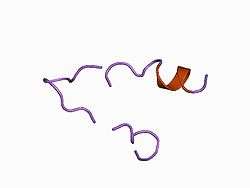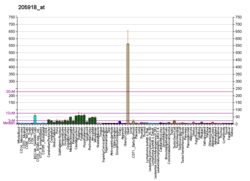Anion exchange protein 3
Anion exchange protein 3 is a membrane transport protein that in humans is encoded by the SLC4A3 gene.[5][6] AE3 is functionally similar to the Band 3 Cl−/HCO3− exchange protein but it is expressed primarily in brain neurons and in the heart. Like AE2 its activity is sensitive to pH.[7][8] AE3 mutations have been linked to seizures.[9][10]
See also
References
- GRCh38: Ensembl release 89: ENSG00000114923 - Ensembl, May 2017
- GRCm38: Ensembl release 89: ENSMUSG00000006576 - Ensembl, May 2017
- "Human PubMed Reference:". National Center for Biotechnology Information, U.S. National Library of Medicine.
- "Mouse PubMed Reference:". National Center for Biotechnology Information, U.S. National Library of Medicine.
- Su YR, Klanke CA, Houseal TW, Linn SC, Burk SE, Varvil TS, Otterud BE, Shull GE, Leppert MF, Menon AG (Jan 1995). "Molecular cloning and physical and genetic mapping of the human anion exchanger isoform 3 (SLC2C) gene to chromosome 2q36". Genomics. 22 (3): 605–9. doi:10.1006/geno.1994.1433. PMID 8001971.
- "Entrez Gene: SLC4A3 solute carrier family 4, anion exchanger, member 3".
- Casey JR, Sly WS, Shah GN, Alvarez BV (November 2009). "Bicarbonate homeostasis in excitable tissues: role of AE3 Cl-/HCO3- exchanger and carbonic anhydrase XIV interaction". Am. J. Physiol., Cell Physiol. 297 (5): C1091–102. doi:10.1152/ajpcell.00177.2009. PMC 2777400. PMID 19692653.
- Hayashi H, Suruga K, Yamashita Y (June 2009). "Regulation of intestinal Cl-/HCO3- exchanger SLC26A3 by intracellular pH". Am. J. Physiol., Cell Physiol. 296 (6): C1279–90. doi:10.1152/ajpcell.00638.2008. PMID 19321737.
- Hentschke M, Wiemann M, Hentschke S, Kurth I, Hermans-Borgmeyer I, Seidenbecher T, Jentsch TJ, Gal A, Hübner CA (January 2006). "Mice with a targeted disruption of the Cl-/HCO3- exchanger AE3 display a reduced seizure threshold". Mol. Cell. Biol. 26 (1): 182–91. doi:10.1128/MCB.26.1.182-191.2006. PMC 1317631. PMID 16354689.
- Vilas GL, Johnson DE, Freund P, Casey JR (September 2009). "Characterization of an epilepsy-associated variant of the human Cl-/HCO3(-) exchanger AE3". Am. J. Physiol., Cell Physiol. 297 (3): C526–36. doi:10.1152/ajpcell.00572.2008. PMID 19605733.
Further reading
- Alper SL, Chernova MN, Stewart AK (2002). "Regulation of Na+-independent Cl-/HCO3- exchangers by pH". JOP. 2 (4 Suppl): 171–5. PMID 11875255.
- Alper SL, Darman RB, Chernova MN, Dahl NK (2002). "The AE gene family of Cl/HCO3- exchangers". J. Nephrol. 15. Suppl 5: S41–53. PMID 12027221.
- Kopito RR, Lee BS, Simmons DM, et al. (1990). "Regulation of intracellular pH by a neuronal homolog of the erythrocyte anion exchanger". Cell. 59 (5): 927–37. doi:10.1016/0092-8674(89)90615-6. PMID 2686841.
- Yannoukakos D, Stuart-Tilley A, Fernandez HA, et al. (1994). "Molecular cloning, expression, and chromosomal localization of two isoforms of the AE3 anion exchanger from human heart". Circ. Res. 75 (4): 603–14. doi:10.1161/01.res.75.4.603. PMID 7923606.
- Morgans CW, Kopito RR (1993). "Association of the brain anion exchanger, AE3, with the repeat domain of ankyrin". J. Cell Sci. 105. ( Pt 4): 1137–42. PMID 8227202.
- Dudeja PK, Hafez N, Tyagi S, et al. (1999). "Expression of the Na+/H+ and Cl-/HCO-3 exchanger isoforms in proximal and distal human airways". Am. J. Physiol. 276 (6 Pt 1): L971–8. doi:10.1152/ajplung.1999.276.6.L971. PMID 10362722.
- Einum DD, Zhang J, Arneson PJ, et al. (2000). "Genomic structure of human anion exchanger 3 and its potential role in hereditary neurological disease". Neurogenetics. 1 (4): 289–92. doi:10.1007/s100480050043. PMID 10732805.
- Soleimani M, Greeley T, Petrovic S, et al. (2001). "Pendrin: an apical Cl-/OH-/HCO3- exchanger in the kidney cortex". Am. J. Physiol. Renal Physiol. 280 (2): F356–64. doi:10.1152/ajprenal.2001.280.2.f356. PMID 11208611.
- Alrefai WA, Tyagi S, Nazir TM, et al. (2001). "Human intestinal anion exchanger isoforms: expression, distribution, and membrane localization". Biochim. Biophys. Acta. 1511 (1): 17–27. doi:10.1016/S0005-2736(00)00366-7. PMID 11248201.
- Sterling D, Reithmeier RA, Casey JR (2002). "A transport metabolon. Functional interaction of carbonic anhydrase II and chloride/bicarbonate exchangers". J. Biol. Chem. 276 (51): 47886–94. doi:10.1074/jbc.M105959200. PMID 11606574.
- Alvarez BV, Fujinaga J, Casey JR (2002). "Molecular basis for angiotensin II-induced increase of chloride/bicarbonate exchange in the myocardium". Circ. Res. 89 (12): 1246–53. doi:10.1161/hh2401.101907. PMID 11739292.
- Wang Z, Petrovic S, Mann E, Soleimani M (2002). "Identification of an apical Cl(-)/HCO3(-) exchanger in the small intestine". Am. J. Physiol. Gastrointest. Liver Physiol. 282 (3): G573–9. doi:10.1152/ajpgi.00338.2001. PMID 11842009.
- Al-Bazzaz FJ, Hafez N, Tyagi S, et al. (2002). "Detection of Cl--HCO3- and Na+-H+ exchangers in human airways epithelium". JOP. 2 (4 Suppl): 285–90. PMID 11875273.
- Sterling D, Alvarez BV, Casey JR (2002). "The extracellular component of a transport metabolon. Extracellular loop 4 of the human AE1 Cl-/HCO3- exchanger binds carbonic anhydrase IV". J. Biol. Chem. 277 (28): 25239–46. doi:10.1074/jbc.M202562200. PMID 11994299.
- Strausberg RL, Feingold EA, Grouse LH, et al. (2003). "Generation and initial analysis of more than 15,000 full-length human and mouse cDNA sequences". Proc. Natl. Acad. Sci. U.S.A. 99 (26): 16899–903. doi:10.1073/pnas.242603899. PMC 139241. PMID 12477932.
This article is issued from Wikipedia. The text is licensed under Creative Commons - Attribution - Sharealike. Additional terms may apply for the media files.





